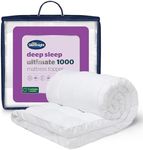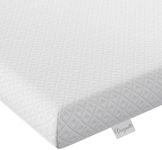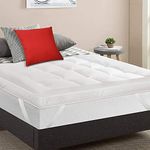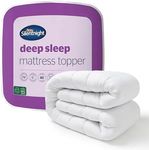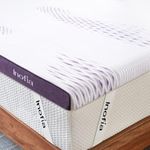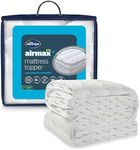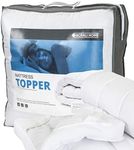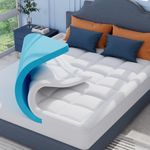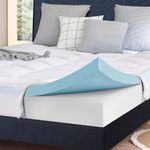Buying Guide for the Best Bed Toppers
Choosing the right bed topper can significantly enhance your sleep quality by providing additional comfort and support. When selecting a bed topper, it's important to consider various factors such as material, thickness, firmness, and specific needs like temperature regulation or pressure relief. Understanding these key specifications will help you make an informed decision that best suits your personal preferences and sleeping habits.MaterialThe material of a bed topper affects its comfort, support, and durability. Common materials include memory foam, latex, down, and wool. Memory foam is known for its contouring support and pressure relief, making it ideal for those with joint pain. Latex is durable and offers a bouncy feel, suitable for those who prefer a firmer surface. Down toppers provide a soft, luxurious feel but may not offer as much support. Wool is naturally breathable and temperature-regulating, great for those who sleep hot. Choose a material based on your comfort preference and any specific needs like support or temperature regulation.
ThicknessThickness determines the level of cushioning and support a bed topper provides. Toppers typically range from 1 to 4 inches thick. A 1-2 inch topper adds a slight layer of comfort and is suitable for those who want to enhance their mattress without significantly altering its feel. A 3-4 inch topper offers more substantial support and is ideal for those looking to address specific issues like pressure points or an overly firm mattress. Consider your current mattress condition and how much additional comfort you need when choosing the thickness.
FirmnessFirmness affects how a bed topper feels and supports your body. Toppers can range from soft to firm. A soft topper provides a plush, cushioned feel, suitable for side sleepers or those who prefer a softer surface. A medium-firm topper offers a balance of comfort and support, ideal for back sleepers or those who want a moderate level of firmness. A firm topper provides strong support and is best for stomach sleepers or those who need extra support for their back. Choose the firmness level based on your sleeping position and personal comfort preference.
Temperature RegulationTemperature regulation is important for maintaining a comfortable sleep environment. Some materials, like memory foam, can retain heat, while others, like latex and wool, are naturally breathable and help regulate temperature. If you tend to sleep hot, look for toppers with cooling features such as gel-infused memory foam or breathable materials like latex and wool. If you tend to sleep cold, a down or memory foam topper may provide additional warmth. Consider your typical sleep temperature and choose a topper that helps maintain a comfortable sleep climate.
Pressure ReliefPressure relief is crucial for reducing discomfort and preventing pain, especially for those with joint or back issues. Memory foam toppers are known for their excellent pressure-relieving properties as they contour to your body and distribute weight evenly. Latex toppers also offer good pressure relief with a slightly firmer feel. If you experience pressure points or pain, opt for a topper that provides adequate support and cushioning to alleviate these issues. Assess your specific needs for pressure relief and choose a topper that addresses them effectively.
Motion IsolationMotion isolation is important for couples or those who share a bed, as it minimizes the transfer of movement from one side of the bed to the other. Memory foam toppers are particularly effective at isolating motion, making them a good choice for light sleepers who are easily disturbed by their partner's movements. Latex toppers also offer decent motion isolation but with a bit more bounce. If you share your bed and are sensitive to movement, consider a topper with good motion isolation properties to ensure an undisturbed sleep.

